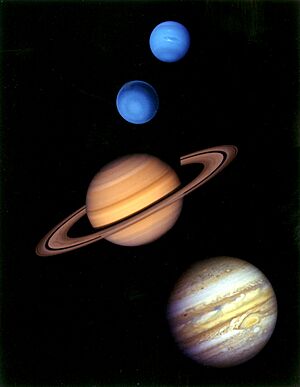Outer planet facts for kids
The outer planets are the four amazing planets in our Solar System that are found beyond the asteroid belt. These giant worlds are Jupiter, Saturn, Uranus, and Neptune. They are all called gas giants because they are mostly made of gases like hydrogen and helium, not solid rock like Earth. Each of these incredible planets also has its own set of rings made of dust and tiny icy bits!
Contents
The Outer Planets
The four outer planets are much bigger than the inner planets (like Earth and Mars). They are also very different in what they are made of. While Earth has a solid surface you can stand on, the gas giants do not. Instead, they have thick atmospheres that get denser and hotter as you go deeper.
These planets are very cold because they are so far from the Sun. They all have many moons orbiting them, and as mentioned, they all have ring systems, though Saturn's are the most famous.
Jupiter: The King of Planets

Jupiter is the largest planet in our Solar System. It is so big that all the other planets could fit inside it! Jupiter is mostly made of hydrogen and helium gas. It spins very fast, which causes its clouds to form colorful bands and swirls.
One of Jupiter's most famous features is the Great Red Spot. This is a giant storm that has been raging for hundreds of years. It is even bigger than Earth! Scientists have studied it for a long time using spacecraft like Voyager 1 and Galileo.
Jupiter has at least 95 known moons. The four largest are called the Galilean moons: Io, Europa, Ganymede, and Callisto. These moons are fascinating worlds, with some possibly having oceans beneath their icy surfaces.
Saturn: The Ringed Beauty
Saturn is famous for its stunning and complex ring system. These rings are made of billions of tiny pieces of ice and rock, ranging from dust-sized particles to chunks as big as mountains. They stretch out for hundreds of thousands of kilometers but are incredibly thin.
Like Jupiter, Saturn is a gas giant made mostly of hydrogen and helium. It is the second-largest planet in our Solar System. Saturn also has many moons, with over 140 discovered so far. Its largest moon, Titan, is unique because it has a thick atmosphere and lakes of liquid methane on its surface.
Uranus: The Sideways Spinner
Uranus is an unusual planet because it spins on its side! Most planets spin like a top, but Uranus is tilted almost 90 degrees. Scientists think a giant collision long ago might have caused this strange tilt.
Uranus is an "ice giant," meaning it has more ice (like water, methane, and ammonia) than Jupiter or Saturn. It has a blue-green color because of the methane gas in its atmosphere. Uranus has a faint ring system and 27 known moons.
Neptune: The Windy World
Neptune is the farthest planet from the Sun in our Solar System. It is also an "ice giant" like Uranus and looks very blue. Neptune is known for having the strongest winds in the Solar System, which can blow faster than the speed of sound!
Neptune has a few faint rings and 14 known moons. Its largest moon, Triton, is special because it orbits Neptune in the opposite direction of the planet's spin. Triton is also one of the coldest places in the Solar System.
Want to Learn More?
- Moons of Jupiter
- Rings of Jupiter
- Moons of Saturn
- Rings of Saturn
- Moons of Uranus
- Rings of Uranus
- Moons of Neptune
- Rings of Neptune
- Inner planet
Images for kids
-
The Galileo Probe plunged deep into Jupiter in 1995. It was carried to the Jovian system by the Galileo spacecraft, where it was released and survived what was then the highest-velocity atmospheric entry yet attempted.




